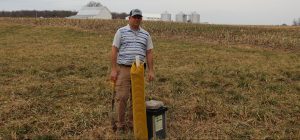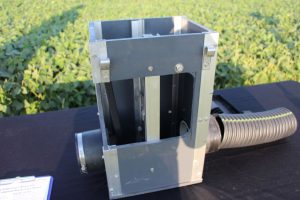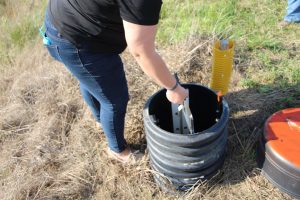Agronomy, Conservation, Homepage Slider, Water Quality
Drainage water management and winter cover crops
By Vinayak Shedekar, Rachel Cochran and Boden Fisher
With water-level control structures for controlled drainage gaining popularity in farms across Ohio, some questions about the management practice have surfaced, including this one: How can we effectively utilize both controlled drainage and winter crops?
The NRCS Practice Standard 554 recommendation is to raise the outlet elevation of the water control structure to within 12 inches or less of the ground surface during non-cropped (fallow) periods. Ordinarily, this wouldn’t pose any issues, as there isn’t a need for field trafficability in the wintertime. However, having a water table within 6 inches to 12 inches of the soil surface while a crop is growing in that field may pose some risk for the crop’s root growth and yield potential. We spoke with experts in and around Ohio and a few farmers who are already using controlled drainage and winter crops to find out how they are managing both practices.
The majority of the farmers we talked to slightly adjust their management when utilizing controlled drainage with winter crops. None of the interviewed farmers changed winter crops selection for controlled drainage to species with shorter or more shallow root systems. Instead, they plant the same cover crops or winter wheat varieties that they would plant on a field without drainage water management and adjust the water table depth accordingly. Some farmers utilize passive control structure management, where they set the board heights in the fall and leave them in the same place all winter. Others utilize active or adaptive management techniques, where they adjust the board height on a schedule or in response to field and crop conditions during the winter.
What does the research tell us?
Extensive research from Ohio and across the Midwest indicates that controlled drainage can substantially reduce drainage discharge and associated nitrate losses compared to free drainage at drain depth. Studies in Ohio have also shown 6% and 3% yield benefits to corn and soybean, respectively, if drainage water management was continued during cash crop growing season. However, there is very limited research related to the effect of controlled drainage on cover crop or winter crop growth.  Some studies in Europe suggest that too shallow (6 inches or less) water table could cause significant waterlogging stress in winter wheat. When the water table was set at 12 inches or deeper, wheat experiencing partial or complete waterlogging for up to 14 days could still recover in terms of N-uptake and yield potential. Thus, excessively high water table conditions (within 6 inches of the surface) over a long, wet period (2+ weeks) likely pose a greater risk to winter crops.
Some studies in Europe suggest that too shallow (6 inches or less) water table could cause significant waterlogging stress in winter wheat. When the water table was set at 12 inches or deeper, wheat experiencing partial or complete waterlogging for up to 14 days could still recover in terms of N-uptake and yield potential. Thus, excessively high water table conditions (within 6 inches of the surface) over a long, wet period (2+ weeks) likely pose a greater risk to winter crops.
It is important to remember that the water held back behind a control structure doesn’t always stay in the soil profile like it would in a tank. Losses of water to evapotranspiration, natural deep percolation and lateral seepage pathways will result in lowering the water table even when you do not see any water leaving the tile outlet. Therefore, in a typical Ohio winter and spring, it is less likely that winter crops under controlled drainage would experience excessive wet stress, severe enough to cause major negative impacts on their growth, especially if the mix involves species that can tolerate some waterlogging.
How should one manage control structures for winter crops?
Early to late fall (winter crop establishment) — Similar to cash crops, drainage is essential for the establishment and growth of crops in majority of poorly drained soils of Northwest Ohio. So, keep the system under free drainage until you have finished planting cover crops after harvest. After the field operations in fall, set the boards at the standard recommended heights for controlled drainage (typically 1 to 1.5 feet below surface). Setting boards at recommended depths should not have negative effects on the crop, since most cover crops are still in their initial growth phases, and do not yet have deep roots.
Early to late spring (winter crop growth) — The NRCS Practice Standard 554 suggests that “in fields with winter cover crops, lower the outlet elevation during winter to within 0.5 feet of the expected cover crop rooting depth.” This “active” control structure management strategy should involves making gradual changes to board heights per the type of winter crops and their growth stage and learning through trial and error. The challenging part is knowing how deep the roots are at any given time and having to revisit the control structures multiple times. For producers who maintain multiple structures, this may be a significant time commitment.  In such cases, setting boards at 18-24 inches below a control elevation in the field may be sufficient in early spring. Regardless, be more watchful of the field conditions and weather forecasts if you have wheat or cover crops in a field managed with controlled drainage structure(s). One might think that setting the water table at 24 inches, instead of 12 inches below surface may take away some of the water quality benefits of controlled drainage. But the growing winter crops uptake significant amounts of nutrients that would otherwise be at the risk of being lost from the soil, and likely make up for the potential increase in nutrient loss with a lower-than-recommended controlled drainage.
In such cases, setting boards at 18-24 inches below a control elevation in the field may be sufficient in early spring. Regardless, be more watchful of the field conditions and weather forecasts if you have wheat or cover crops in a field managed with controlled drainage structure(s). One might think that setting the water table at 24 inches, instead of 12 inches below surface may take away some of the water quality benefits of controlled drainage. But the growing winter crops uptake significant amounts of nutrients that would otherwise be at the risk of being lost from the soil, and likely make up for the potential increase in nutrient loss with a lower-than-recommended controlled drainage.
A few additional considerations
If you are new to both, controlled drainage and cover crops, consider choosing cover crop species that are more tolerant to waterlogging conditions and avoiding species that are more susceptible to brief flooding. The Midwest Cover Crops Council Selector Tool available at https://mccc.msu.edu/selector-tool is a great resource for such decision making.
Automated control structures (despite their high initial cost) may prove to be useful, especially in cases where wet conditions may prevent you from accessing the structures or having to manage too many control structures in a short period of time.
If your operation involves use of liquid manure, follow the guidance and recommendations for control structure management before-and-after liquid manure application. Proper management of control structures can help prevent direct leakage of manure into drainage pipes through soil macro pores (cracks, wormholes, root channels). Maintaining the raised outlet elevation for at least 15 days following manure application or until the next precipitation event that produces drain flow is a recommended strategy (NRCS).
Dr. Vinayak Shedekar is a Research Scientist, OSU Department of Food, Agricultural and Biological Engineering and can be reached at shedekar.1@osu.edu. Rachel Cochran is OSU Water Quality Extension Associate serving Paulding, VanWert, and Defiance counties, and can be reached at cochran.474@osu.edu Boden Fisher is a former OSU Water Quality Extension Associate and served Putnam, Hancock & Hardin Counties. This column is provided by the OSU Department of Food, Agricultural and Biological Engineering, OSU Extension, Ohio Agricultural Research and Development Center, and the College of Food, Agricultural, and Environmental Sciences. Inputs were also provided by expert members of the Conservation Drainage Network.